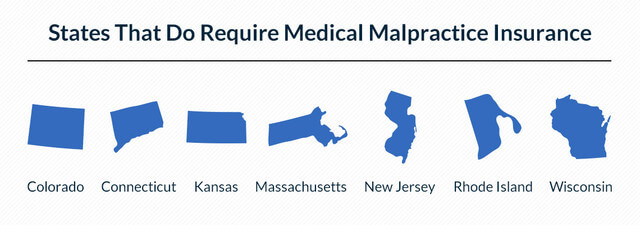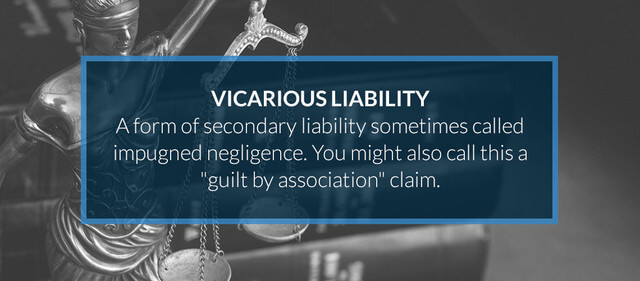
Going Bare - Are Doctors Required to Have Malpractice Insurance?
Gallagher Healthcare :: Industry Insights
By Donovan Weger | 3/20/2017Updated on 3/19/2021

Going bare has morphed into an insurance term which means that a medical provider is practicing without professional liability or medical malpractice insurance. This trend has decreased over the past 10 years as meaningful tort reform in many states has made it more affordable for physicians to purchase professional liability.
However, physicians continue to go without insurance, or “go bare.”
Why Doctors Practice Without Malpractice Insurance
One of the primary reasons for going bare is cost. Tort reform has occurred in the majority of states which has resulted in a drastic premium reduction. High-risk counties that were once uninsurable now have multiple carriers competing. In addition, specialties such as OB/GYN, Neurosurgery and Orthopedics are now much easier for carriers to underwrite. Despite these factors, there are still doctors who do not think that there is an affordable alternative to going bare.
Another reason that providers choose to go without medical malpractice insurance is that they believe they will be less of a target if they do get sued. They think that once an attorney finds out they do not have insurance, the case will be dropped as a result of a lower potential for "winnable assets." This may apply in some very limited situations, but attorneys still have the ability to go after the assets of the provider or their business.

Going bare does not guarantee that you will not be a target or ultimately face the possibility of paying a plaintiff attorney.
Are Doctors Required to Have Medical Malpractice Insurance?
No federal law requires doctors to carry medical malpractice insurance, but some states do. Whether or not doctors are required to have insurance depends upon the state where they practice. Roughly 32 states require no medical malpractice insurance and have no minimum carrying requirements. The other 18 states break down roughly into two groups — states that require minimum levels of insurance and states that require medical professionals to have some insurance to qualify for liability reforms in their state.
Which States Do Not Require Medical Malpractice Insurance?
The following states do not require medical malpractice insurance nor do they have minimum carrying requirements:
Alabama, Alaska, Arizona, Arkansas, California, Delaware, Florida, Georgia, Hawaii, Idaho, Illinois, Iowa, Kentucky, Maine, Maryland, Michigan, Minnesota, Mississippi, Missouri, Montana, Nevada, New Hampshire, North Carolina, North Dakota, Ohio, Oklahoma, Oregon, South Carolina, South Dakota, Tennessee, Texas, Utah, Vermont, Virginia, Washington and West Virginia.
Even though these states have no requirement for medical malpractice insurance nor minimum carrying requirements, many physicians still face requirements to obtain malpractice insurance in certain situations. Many hospitals require physicians with visiting privileges to obtain malpractice insurance. And some healthcare insurance plans require any doctor who participates in their coverage to have malpractice insurance.

When you dig a little deeper on states that do not require medical malpractice insurance, you can see a doctor still requires malpractice insurance or else they could end up paying a significant sum of money. Going bare will not protect them.
For instance in California, there is a $250,000 cap on non-economic damages. But there is no cap for lost wages. California is a great example of a stable medical malpractice market where a physician, if successfully sued, can still end up having to pay damages in the vicinity of several hundred thousand dollars. Note this does not take into account any legal fees.
Florida is another state with no medical malpractice requirements, but where doctors still should purchase insurance. Before tort reform in 2003, Florida was a state where many doctors chose to go bare rather than purchase insurance because of its relatively high cost. But since 2003, the market for malpractice insurance is much less expensive and has settled down.
Even if a doctor still chooses to go bare, however, there are certain requirements in Florida they must meet. They must post a bond, have an escrow account, get an irrevocable line of credit letter from a bank or other lending agency which cannot be used for legal fees and post a sign in their offices to inform their patients that they do not carry malpractice insurance.
Finally, let's look at Nevada. For many years Nevada was an unstable medical malpractice market, and many carriers withdrew from providing coverage in the state. In 2002, the Nevada Legislature passed reforms that capped non-economic damages at $350,000 but allowed exemptions for exceptional circumstances and gross negligence. These reforms did not keep doctors in Nevada, so the exemptions were removed. As a result, the market is much more stable. But when you consider that a doctor can be sued for as much as $350,000, you can see where going bare is not a great idea.
Which States Require Doctors to Have Malpractice Insurance?

There are seven states that require doctors to maintain a minimum level of malpractice insurance:
Colorado, Connecticut, Kansas, Massachusetts, New Jersey, Rhode Island and Wisconsin.
The levels of malpractice insurance that a doctor is required to carry varies greatly depending on the state.
In Colorado, for instance, there is also a cap on non-economic damages of $250,000 and an aggregate payout of $1 million. However, a court can triple damages if the defendant can show that the physician has willfully continued to perform the action that led to the lawsuit. Thus, state law requires that a physician have minimum medical malpractice insurance of $1 million per incident and a $3 million aggregate limit.
In Kansas, state law requires that physicians maintain a medical malpractice insurance policy with a per limit claim of $200,000 as well as a $600,000 aggregate limit. Kansas also has a program that will help provide insurance for physicians who cannot obtain it from commercial carriers because of “nontraditional” practices or claims. Kansas also requires that healthcare providers participate in the Healthcare Stabilization Fund (HCSF). This provides providers with extra coverage besides the insurance they have purchased from a commercial carrier. Physicians who practice in both Kansas and in Missouri, however, also face a 25 percent surcharge.
Additionally, states including Indiana, Nebraska, New Mexico, New York, Pennsylvania and Wyoming have requirements in place to qualify for state liability reforms. In these states, doctors must maintain a minimal level of insurance if they want to take part in a program run by the state that is designed to help physicians deal with claims.
Depending on the state, these programs either cap damages on a malpractice claim or they provide a patient compensation fund, an effort by the state to provide coverage for certain injuries and extra malpractice insurance for doctors.
In New York, for instance, premiums are very high. Doctors must carry malpractice insurance equal to $1,300,000 per claim with an aggregate limit of $3,900,000 or $1 million per claim with an aggregate limit of $3 million. As well, hospitals require doctors to carry the latter limit of $1 million per claim with an aggregate of $3 million.
Why Medical Malpractice Insurance Makes Sense
As you can see from the statistics and examples presented above, going bare can still leave you at great risk. Purchasing medical malpractice insurance makes sense even in states that do not require physicians to carry malpractice insurance or place a minimum requirement on insurance. Just because a doctor does not have insurance does not mean that they will not be sued if they make a mistake.
And while medical malpractice insurance premiums have been very high in the past, tort reform has stabilized many malpractice insurance markets, making it much easier and less expensive for doctors to acquire the malpractice insurance that they need.

While paying for a lower premium is a key factor for many doctors, there are other important factors to consider:
- According to a survey by the American Medical Association, more than 65 percent of doctors over the age of 55 say they have been sued at least once. While only five percent of doctors are sued yearly, the longer a doctor remains in practice, the greater the chances are that they will be sued at some point. Even though the vast majority of claims are dismissed or dropped, it can still cost around $22,000 for a physician to defend themselves even if a claim is dismissed or dropped. And that cost can run as high as $100,000 according to the report.
- Male doctors are twice as likely to be sued as female doctors. The author of the AMA study suggests that one reason for this is that male physicians are concentrated in medical fields that are most likely to be sued for malpractice. There are also currently greater numbers of older male doctors who are more likely to have been sued than younger female doctors.
- Doctors who work in a practice that focuses on a specialty are more likely to face a malpractice claim than those who work in a group practice that deals with numerous medical conditions or who work in a hospital.
- Some doctors still go bare because they think if they don’t have malpractice insurance, it’s less likely that a dissatisfied patient and their lawyer will sue them. While this may be true in very limited cases, by and large, it is a serious mistake in judgment. Even if a doctor who practices in a state without malpractice insurance and is then sued for the limit of non-economic damages of $250,000, for instance, there are numerous ways that a defendant can seek restitution.
- While it is understandable that many doctors worry about frivolous claims and spurious lawsuits, the reality is that tort reform across the country has greatly limited the amount of money for which a doctor can be sued. Insurance premiums in many states are stable and not cost prohibitive.
- Finally, doctors are humans, and sometimes they do make mistakes. As much as doctors may be concerned about protecting their assets and their practices, most of them recognize that if they have made a mistake, and a patient has suffered, they want to be able to protect those patients and make sure they are fairly compensated.
Reasons to Purchase Malpractice Insurance
1. No Fear of Personal Financial Ruin
We live in a litigious society. Some people will sue at the drop of a hat, especially when prodded to do so by a lawyer. Just one malpractice suit can financially devastate a doctor. Medical malpractice insurance means that even if a doctor is sued, their practice and their personal assets are safe. When purchasing malpractice insurance, make sure that the policy includes errors and oversights, incomplete treatments or services, poor services, professional negligence and misrepresenting any services you might provide.

2. Your Hospital or Your Employer Does Not Provide Enough Coverage
Hospitals always carry some form of medical malpractice insurance to cover their business. The same is true of larger practices. But don’t let this fool you. The coverage provided by hospitals or employers is often not enough to provide for the needs of an individual doctor. This is especially true of legal fees. While the hospital or practice may cover any damages awarded by a jury, the individual doctor can often find themselves out several thousand or hundred thousand dollars in legal fees.
3. Stay Covered No Matter When Claims Are Made
When an employer provides medical malpractice coverage, it is often what is known as “claims-made” insurance. It provides the doctor with coverage as long as they work at that particular facility or practice. But the moment the doctor moves to a new location, they are no longer covered. If a claim is made against them because of something that happened while they were still working for the first employer, neither employer will provide coverage for that claim. So it’s very important that physicians carry personal insurance so they are covered no matter where they work.
4. Win or Lose, Your Legal Costs Are Not a Problem
Roughly 60 to 65 percent of all claims and lawsuits launched against physicians are either dropped or dismissed. But often this does not happen until after some form of legal action has been taken. Lawyers are expensive, and their costs can multiply quickly. If the physician does not have liability insurance, it’s easy for them to go bankrupt just trying to cover legal costs alone.

5. Personal Assets Are Protected
Doctors work hard for many years to achieve the lifestyle they've always desired. If doctors don’t protect their assets with malpractice insurance, they can lose it all. One malpractice claim can wipe away a lifetime of hard work. This is truly a case where it is better to be safe than sorry.
6. Cover Lost Wages
Malpractice insurance can cover any wages that are lost while you are involved in fighting a lawsuit. Time spent in a lawyer’s office, or in a courtroom, means a physician can’t work at their practice or in the hospital doing what they do best. Medical malpractice insurance will make sure that a doctor is covered for any lost wages due to court time or any other actions involved with a malpractice claim.
7. Peace of Mind
Is there any monetary amount that can be placed on peace of mind? It may be the best reason for purchasing medical malpractice insurance. Even if a physician is completely innocent in any claim that is made against them, it is still an incredibly stressful experience. When a physician has malpractice insurance, they know that regardless of the outcome, their practice and their personal assets will be safe, and if a patient does have a legitimate claim, that they will receive the compensation to which they are entitled.
Common Mistakes Doctors Make When Buying Malpractice Insurance
Remember, anybody can be sued. So it’s important that when you’re choosing medical malpractice insurance, you choose the right kind. As we noted above, doctors are human and can sometimes think they are doing the right thing even when they are making a mistake. Here are some common mistakes that can be easily avoided:
1. Not Understanding the Language of Malpractice Insurance
Like any other business, medical malpractice insurance has its own jargon. It’s not difficult, but it’s worth understanding. Here are some terms worth knowing:
- An admitted carrier is one that is licensed and regulated by your state.
- An annual aggregate limit refers to a claims-made policy. It’s the maximum amount the carrier will pay to cover claims during the year.
- The hammer clause requires you to comply with your insurance carrier’s decision to settle a claim, even if you disagree. Certainly worth knowing about.

2. Not Understanding Your Coverage
Never assume. Regardless of the type of insurance that you are considering purchasing, it makes sense not to assume that it covers everything. Make sure you have a complete copy of your policy and talk to your insurance broker about any questions you might have. Tell your broker about all the extra procedures you perform, even if you work in a specific area. Doctors frequently make the mistake of thinking that they are covered for all contingencies when they are only covered for certain procedures. Ask questions. Know what your policy says.
3. Having Holes in the Dates of Your Coverage
Insurance companies and their brokers write most malpractice insurance in a claims-made form. So if a doctor is sued, the insurance company will only cover the claim if the particular incident occurred after a policy's retroactive date and is reported while the coverage is still current. The average patient does not file a medical malpractice lawsuit until more than 16 months after a problem has occurred. So it’s important not to leave any gaps in your coverage.
4. Not Having Vicarious Liability
This is a form of secondary liability sometimes called impugned negligence. You might call this a "guilt by association" claim. You didn’t cause the damage, but your legal relationship with the doctor who did puts you at risk. This is a particular problem if you share office space with another doctor. You can spend a lot in legal fees trying to remove yourself from a lawsuit if someone sues your fellow doctor.

5. Trying to Find the Best Deal All by Yourself
It makes sense to try to keep your medical malpractice costs under control. But think of it like this – if you decide to learn to golf and want the best equipment at a reasonable price, you won't consult your mail carrier. You would talk to a professional who knows about the sport and can help you find the best deals. It’s the same with medical malpractice insurance. When you work with professional medical malpractice insurance broker such as Arthur J. Gallagher & Co., you can focus on your practice while they find you the right coverage.
Practicing without medical malpractice insurance has become less popular. However, it is still being chosen as an option by healthcare providers.
Before making this choice, physicians should ask themselves:
- What is the maximum cost I can afford if something goes wrong?
- Are all of my assets protected in the event I choose to go without insurance?
- Does my state require that I carry a minimum level of insurance?
As a healthcare provider, you have spent an immense amount of time and money investing in your career. In almost all cases, going without medical malpractice insurance can be a costly decision.
Let Gallagher Healthcare Help You Find the Right Coverage for Your Unique Needs
At Gallagher Healthcare, we are experts at specific state medical malpractice laws throughout the United States and are happy to help with any questions you have on minimum coverage requirements. We also represent a wide range of carriers which allows us to tailor a policy to your unique needs and budget, while still providing appropriate coverage levels.

You can learn more about our medical malpractice insurance or contact us today with your questions. You can also request a free, no-obligation quote tailored to your needs.
Updated on 8/20/2018